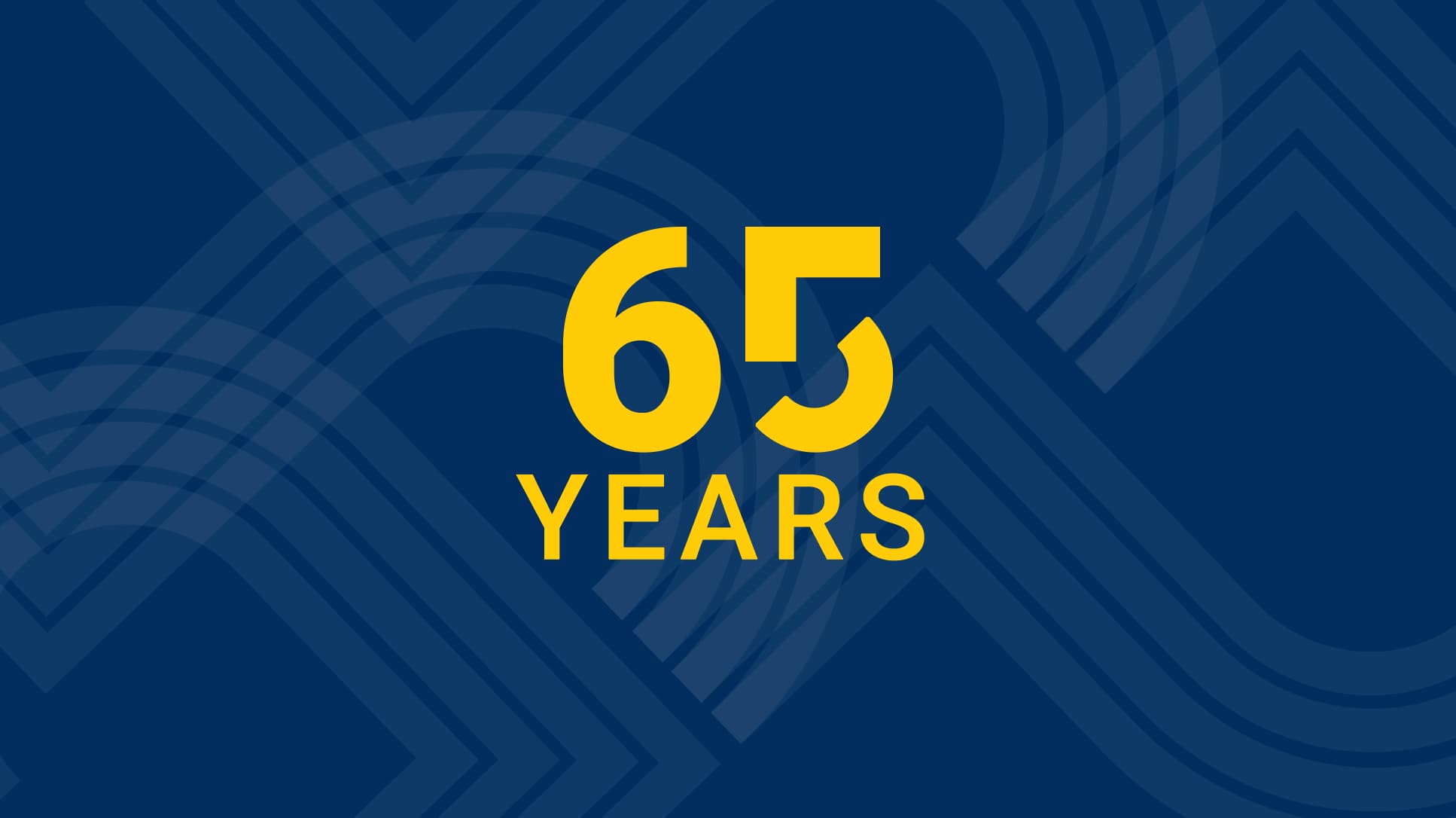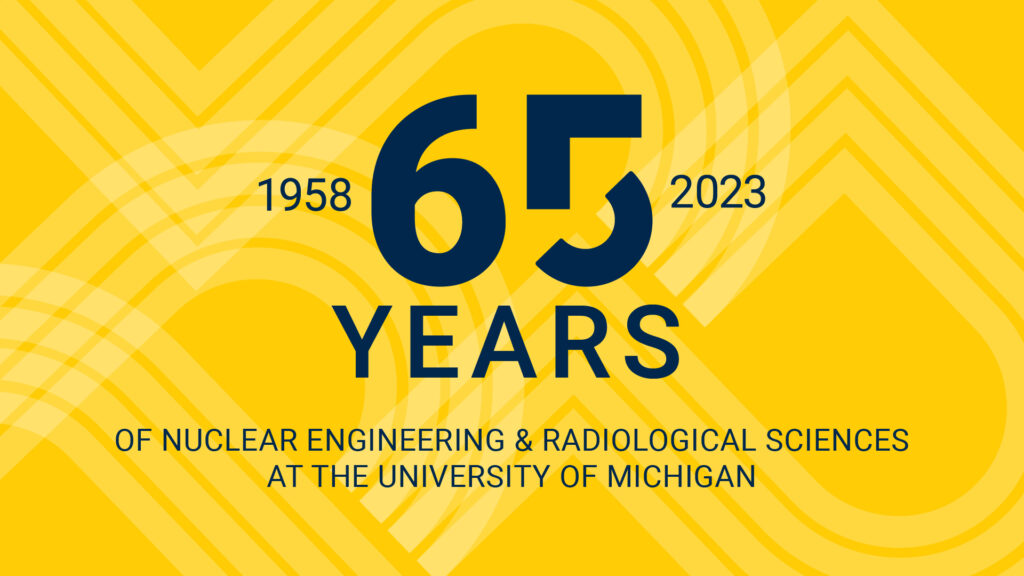
NERS celebrates 65 years
From pioneering beginnings to cutting-edge laboratories, groundbreaking research endeavors, and sustainable energy innovations in nuclear engineering and radiological sciences.

From pioneering beginnings to cutting-edge laboratories, groundbreaking research endeavors, and sustainable energy innovations in nuclear engineering and radiological sciences.

This summer, the Department of Nuclear Engineering & Radiological Sciences (NERS) marked its 65th year as a department at the University of Michigan. Since its establishment in 1958, the department has remained steadfast in its commitment to driving progress in nuclear engineering and radiological sciences, propelled by a dedication to pioneering research, progressive education, and transformative technological strides.
“In the same year that the USS Nautilus crossed under the North Pole, proving the unique value of nuclear energy to military applications, NERS was created to optimize the value of nuclear energy towards improving lives from energy to health,” said NERS Chair Todd Allen. “Sixty-five years later, NERS still leads in advancing nuclear technology across clean energy, environment & health, national security, and basic science. This is a great opportunity to celebrate our successes and motivate the future.”
NERS holds the distinction of being the country’s oldest degree program and the second-oldest department of its kind. This history dates back to the late 1940s when the Department of Aeronautical Engineering initiated a specialized graduate program for Air Force officers at the university. This program included a classified course that covered introductory material in neutron-nuclear physics and reactor physics, with a focus on diffusion theory and basic criticality calculations.
As the 1950s dawned, the course’s material was declassified, prompting its expansion to the broader college audience. The growing interest in nuclear energy spurred the introduction of additional courses like Radiation Measurements, Radiation with Matter, and Industrial Applications of Radiation, taught across various engineering disciplines. This burgeoning interest prompted the establishment of an interdepartmental committee in 1952 to oversee a formal graduate program in Nuclear Engineering.
During this time, plans were also set in motion to construct a research reactor as part of the Michigan Memorial Phoenix Project (MMPP), a “living memorial” built to honor the 585 university alumni, students, faculty, and staff members who gave their lives in World War II. The program’s commitment to advancing peaceful nuclear energy applications attracted more students and attention. The Ford Nuclear Reactor (FNR), funded by a grant from Ford Motor Company, achieved initial criticality in 1957, becoming the third reactor of its kind on a university campus in the United States.
By 1954, the first Master’s degree in Nuclear Engineering was granted, followed by the awarding of the first three PhD degrees in 1958. The program flourished, with around 110 graduate students and a dedicated faculty including Henry Gomberg, William Kerr, John King, Paul Zweifel, Edward Martin, Richard Osborn, Lloyd Brownell, and George West.
The University of Michigan’s pioneering role in nuclear studies was further emphasized by the establishment of the first student chapter of the American Nuclear Society in 1955. The department initially offered exclusively graduate programs, including Master’s, professional, and doctoral degrees, setting a precedent for PhD programs in Nuclear Engineering and Nuclear Science.
In 1958, following approvals from the Engineering College and University administration, the Department of Nuclear Engineering was officially formed, with Henry Gomberg serving as the inaugural department chair. The department continued to expand its offerings, introducing an undergraduate program in Nuclear Engineering in 1965, and assuming direction of the College’s Engineering Physics program in 1980.
Over time, the department’s teaching and research evolved beyond traditional nuclear engineering, encompassing areas like plasma physics, materials science, radiological health, and medical physics. This diversification led to the department’s name change in 1995 to the Department of Nuclear Engineering and Radiological Sciences.
At the outset, the NERS departmental office was situated within the Automotive Laboratory (now the Walter E. Lay Automotive Engineering Laboratory) on North Campus, while faculty offices and laboratories were accommodated in the Michigan Memorial Phoenix Project and the Fluids Laboratory (now the G. G. Brown Laboratory). A significant move occurred in 1978, when both the departmental office and the majority of faculty offices were relocated to the Cooley Laboratory on North Campus.
Today, the department’s array of cutting-edge laboratories is strategically placed throughout North Campus to promote interdisciplinary collaborations across the college. With their state-of-the-art equipment and advanced technologies, these labs embody the forefront of research in nuclear engineering and radiological sciences. The department’s commitment to innovation and comprehensive exploration is evident in its diverse range of labs, including the Michigan Ion Beam Laboratory, the Plasma, Pulsed Power and Microwave Laboratory, the Detection for Nuclear Nonproliferation, the Thermal Hydraulics Laboratory, and High Field Science Laboratory, and more. Their capabilities align with those found in leading national labs, underscoring the department’s dedication to pushing the boundaries of scientific discovery and technological advancement in the field.
The department’s original facility, the Ford Nuclear Reactor, operated successfully from 1957 to 2003, after which it underwent decommissioning. In 2017, the renovated reactor building reopened as the Nuclear Engineering Laboratory, featuring cutting-edge equipment for detailed coolant flow imaging, advanced radiation detectors, and nuclear material identification. Direction of the Michigan Memorial Phoenix Project was returned to the department in 2021, leading to plans for a memorial rededication in 2022.
The Fastest Path to Zero Initiative, established by the department in 2019, is squarely dedicated to steering us toward a future free from emissions by optimizing clean energy deployment through interdisciplinary analysis, innovative energy solutions, and community engagement. Against the backdrop of mounting environmental concerns, the role of zero-carbon nuclear energy in this endeavor has become exceptionally significant. To date, the Initiative has built six tools to help communities, researchers, developers, and policymakers evaluate the local suitability of advanced nuclear energy technology adoption. The Fastest Path team’s efforts also transcend laboratory boundaries, facilitating the hosting of numerous clean energy workshops and supporting multiple studies centered on equitable energy transitions.
Also established in 2019, the Consortium for Monitoring, Technology, and Verification (MTV) is led by NERS and comprises 14 universities and 13 national laboratories. MTV is a nationwide collaboration with a resolute mission: to pioneer novel technologies that detect and discourage nuclear proliferation activities while nurturing the next generation of nuclear professionals. The urgency of this mission is underscored by the pressing need to forestall the dissemination of nuclear weapons, a formidable challenge that could instigate domestic turmoil, geopolitical instability, and worldwide economic disruption. MTV plays a decisive role in surmounting these challenges, bolstering the nation’s capability to identify and comprehend the indicators of nuclear weapons development and noncompliance with treaty obligations.
Having received the top ranking by U.S. News & World Report 15 times in the last 16 years, NERS stands out as the premier institution for nuclear engineering education and research. This distinction is underpinned by a rich legacy of pioneering contributions, a commitment to innovation, and a distinguished faculty of experts who are shaping the future of the field. We offer an unparalleled learning environment that fuses a comprehensive curriculum with our state-of-the-art laboratories, enabling students to explore the forefront of nuclear technology. Moreover, NERS cultivates a culture of collaboration, facilitating partnerships with renowned national laboratories, industry leaders, and interdisciplinary endeavors that amplify its impact on global challenges. Through its visionary leadership, dynamic academic programs, and groundbreaking research endeavors, NERS has firmly established itself as the beacon of excellence in nuclear engineering, setting the standard for the nation and beyond.